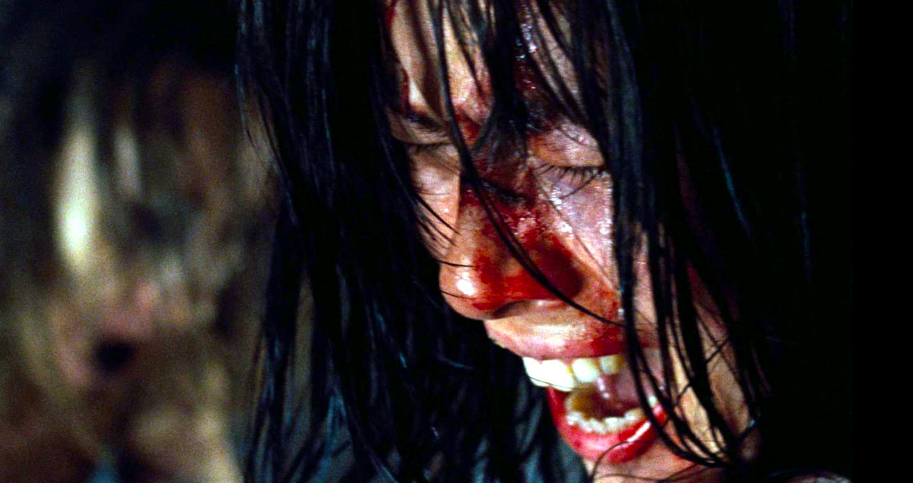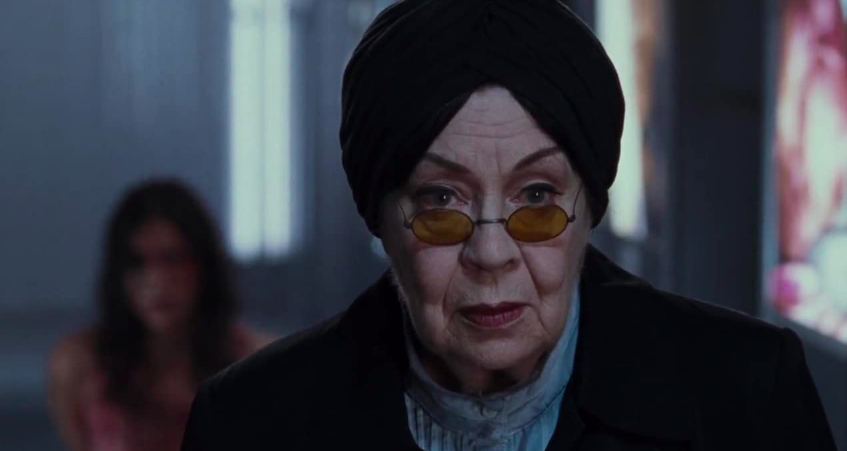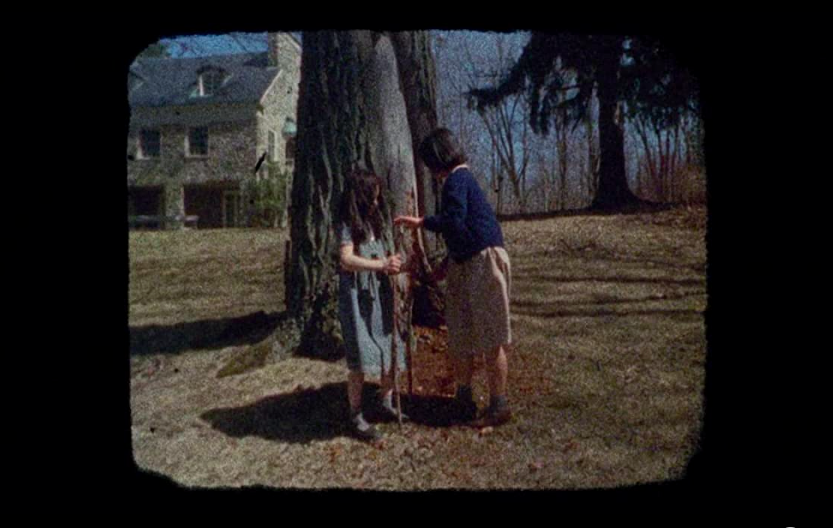‘Martyrs’, Victims, and a World Beyond Suffering [Matriarchy Rising]

Pascal Laugier’s Martyrs is known in horror circles as the pinnacle of the New French Extremity movement. Released in 2008, the film follows Lucie (Mylène Jampanoï) and Anna (Morjana Alaoui), two young women who form an unshakeable bond in defiance of a cult based on the torture of women. Led by a matriarch known only as Mademoiselle (Catherine Bégin), the cult is designed to produce martyrs, a person who has been transfigured through suffering and found a way to see what lies beyond death. Laugier’s film is an extremely difficult watch, punishing the audience with scene after scene of violence and torture. Though infamous for its brutal flaying sequence, Martyrs is at its core a film about women. Mademoiselle is the leader of a matriarchy gone terribly wrong and her cult is a perfect example of the cruelty and sacrifice women have been conditioned to expect in a patriarchal world.
Fifteen years after escaping unspeakable torture as a child, Lucie discovers the location of her captors and brutally murders them on a quiet Sunday morning in their home. Anna, a friend Lucie met in the aftermath of her rescue, has become a sort of caretaker for the troubled girl and rushes to her side after the murders. While confronting her torturers gives Lucie some catharsis, she is still haunted by her immense trauma and devastated that Anna cannot fully believe her story. She dies by suicide, adding her body to the massacre. Consumed with guilt for doubting Lucie, Anna is still grieving when the remaining cult members find her at the house and drag her into their underground lair.
Once Anna has become a captive, she learns the horrific purpose of this cruelty. Mademoiselle shows her a series of photographs and describes the practice of creating a martyr. Over the years they have developed various stages of torture designed to feed and prolong the suffering of a chosen victim until they transcend their physical surroundings and see beyond the veil of death. The cult has created many victims over the years including Lucie, but never succeeded in creating a true martyr who can experience this transfiguration through pain.

Martyrs is filled with strong women, both cruel and kind. Mademoiselle is the unquestioned leader of the cult and Gabrielle Belfond (Patricia Tulasne), Lucie’s one-time captor and mother of the family she murders, is a quasi-caregiver and facilitator of the cult’s torture. Lucie and Anna are two of four unfortunate women who fall into the cult’s painful clutches. There are no male characters of consequence in the film. They exist only to tell the story and to support women in positions of power. Though the cult is led by a woman, this choice of targets is evidence of a patriarchal worldview in which women are sacrificed to benefit those in power. After decades of experimentation, Mademoiselle has found that young women are the most receptive to transfiguration.
Mademoiselle’s world (and the one we live in) is built on the backs of women. Traditional expectations for people who identify as female include bearing and caring for children, maintaining the home, and providing pleasure for men. Assigned lesser value from birth, we are constantly expected to give of ourselves for the comfort and survival of others. Generations of girls have been brought up to expect and even desire the pain of this sacrifice, taught that it’s simply part of being female. It’s no wonder young women, raised to transform based on the demands of their environment, would prove especially adept at martyrdom.

Mademoiselle claims young women make the best martyrs, but this is the only demographic we actually see the cult torture. It’s possible she chooses young women because they are the types of victims she feels most comfortable destroying. The name she chooses also betrays her motives. In striking contrast to the image of a young, unmarried woman her moniker implies, Mademoiselle is an old woman. Clinging to her youth, she has dedicated her life to reassurances about the afterlife she will soon face.
As many women age, they begin to resent the youth and beauty of the young because they know that is what’s most prized in a misogynistic society. It’s no wonder that as she ages, Mademoiselle assumes the identity of a young woman while destroying those who authentically embody it. Perhaps this is why she is able to torture these women so coldly. Her terror of aging and death manifests in the destruction of the status she once had. Mademoiselle is also a term used by an older generation. Many in France now consider the word sexist and its use, solely designed to indicate a woman’s marital status, was banned from French documents in 2012, just four years after Martyrs premiered. By choosing this title for herself, she is clinging to an identity and ideology quickly falling out of fashion in modern France.
Mademoiselle is hardly the first woman to turn against her own kind. Many have accepted the fact that they will never reach the top of the patriarchal ladder and content themselves with climbing as high as they can no matter who they have to step on to get there. The targets Mademoiselle chooses are indicative of the bleak worldview she has internalized. She describes martyrs as extraordinary beings, but she has no problem using and discarding them for her own benefit.
The painful truth is that not all systems led by women exist to make us stronger. Sometimes the women in leadership positions only want to help themselves. They cultivate their power in order to prop up a larger patriarchal system. This betrayal stems from fear. Having adopted the belief that humanity is built on female victims, they turn on each other to make sure they won’t be the ones to fall into the gears. It’s a zero-sum game of suffering designed to distract us from those at the very top of the ladder content to watch us fight amongst ourselves.

Mademoiselle notes that the trauma of her torture causes victims to see things that are not there. Lucie sees the shadow of the woman she was unable to save when she escaped as a child. Anna begins to see and hear Lucie. Though she doesn’t appear on-screen, Anna begins to talk to her friend and asks her how to cope with the unending misery. Lucie’s advice is to let go. Terrified, Anna asks Lucie to stay with her through it all and it’s this connection that allows her to transcend the pain she endures. The brutal beatings visited on Anna continue, but the music changes to a more hopeful tone. As Anna lets herself go, remembering her love for Lucie, she begins to transform.
After the systematic removal of her skin, Anna enters what the cult describes as a state of ecstasy. She ceases to see her physical surroundings and gazes skyward into a vision of the afterlife. The cult has successfully produced a martyr. Rushing to Anna’s side, Mademoiselle stoops to hear a description of what she’s seen while the rest of the cult gathers to hear her report. They are wealthy older couples who arrive in luxury cars and posh clothing, an older generation willing to sacrifice the young for their own comfort.
Knowledge of the afterlife will not stop the deaths they will all soon face, it will only provide comfort in their final years. Perhaps what they really seek is proof that they will not be damned for the pain they have caused. Fearing the loss of power that will come with death, they are desperate for some kind of proof that the way they have lived their lives will be rewarded in the afterlife to match the wealth they have amassed on earth.
Women who spend their lives empowering themselves by keeping others down would likely seek this same validation. Politicians who vote to limit reproductive freedom, lawyers who enable serial predators, and parents who ignore claims of abuse are all examples of women who selfishly maintain the status quo while betraying other women. They tell themselves that the means justify the ends, but they are not the ones paying the price. They are requiring it of others. It’s likely that some part of them knows how selfish their actions truly are and they are desperate to find absolution as they fear the damnation that will surely await them.

We never learn what Anna sees. With the words “keep doubting” on her lips, Mademoiselle dies by suicide before addressing the group. Laugier chooses not to show us Anna’s vision and has declined to speculate after the fact. What we do know is that Anna’s unconditional love for Lucie is what allows her to escape their torture. She lets her body go and finds peace in the imagined companionship of her best friend and soulmate. Perhaps what Anna sees is a world based on this kind of love, a world not built upon the suffering of others where women support each other instead of tearing each other down. Mademoiselle is a woman who survives by destroying other women and there would be no place for her in this world.
Martyrs concludes with a new definition of its title: “martyr – a witness.” Of the film’s brutality, Laugier has said, “I really needed the audience to feel the pain, to reach our limits, so maybe it would reach another level after the pain, like my main character does, reaching some transcendent state.” In witnessing Anna’s torture, we have become martyrs along with her. As the credits roll, Laugier gives us our own transcendent vision: footage of Lucie and Anna playing together as children. Anna’s unconditional love and support for Lucie has destroyed Mademoiselle’s reign of torture. It has the power to transform us all.
Before she dies, Mademoiselle washes her face, removing the false eyelashes and hairpiece that make up her signature look. It’s as if she is deconstructing her own specific brand of womanhood. Maybe what Anna sees is a condemnation of the feminine sacrifice Mademoiselle has spent her life cultivating. Maybe she does not want to die as this type of woman. This is the heartbreaking truth about Mademoiselle’s version of matriarchy. Sometimes the women we look to for leadership turn out to be the ones feeding our suffering. Sometimes, in order to empower ourselves, we have to turn away from the mothers who came before us.
It’s an imperfect metaphor. Letting go could easily be interpreted as giving up the will to live and submitting to those in power, but Laugier’s incredible ending reveals his hopeful intention. Though her suffering is horrific, in letting her body go, Anna has taken back control of her spirit. Her belief that Lucie will support her through the worst of her pain has allowed her to let go of her fear and see a world beyond Mademoiselle’s cruelty. She does not survive the film, but if we are to view the cult’s world as one of patriarchal power, then we can also view escaping it as a death of another kind. Anna is a witness to the power of loving connection available to us all. Though we live in a world that requires our suffering, we can transcend it. We just have to be willing to let ourselves go.
Categorized:Editorials Matriarchy Rising News
